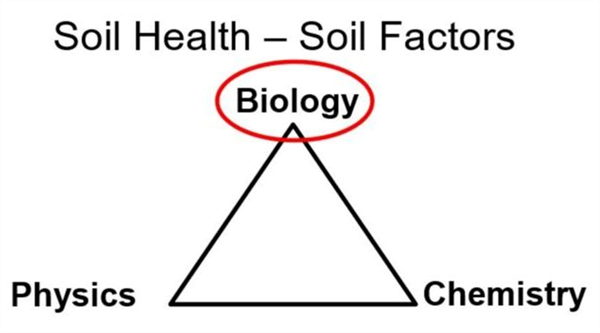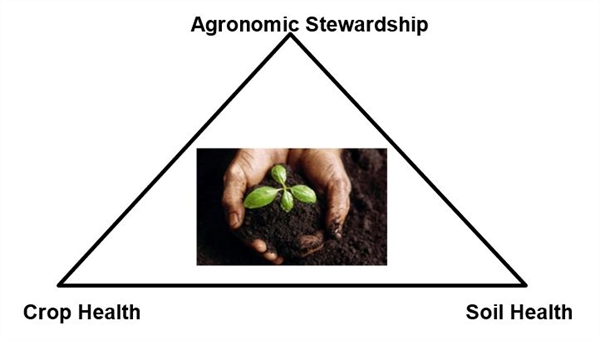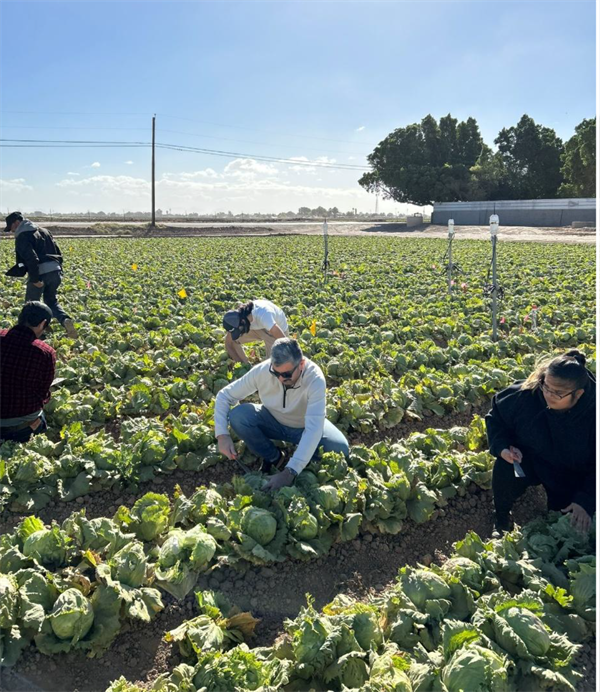
Soil is a natural component of terrestrial ecosystems, both native and agricultural. Soils are the foundation of plant and crop production systems (Brady and Weil, 2008; Parikh and James, 2012).
In terms of soil health, a good way to consider a soil system is from the standpoint of three main categories (physics, chemistry, and biology) that are fundamentally important with healthy soil function (Figure 1).

Figure 1. Soil health factors and chemical properties.
It is estimated that soil contains at least a quarter of the biological diversity (aka biodiversity) on our planet. Soils are second only to the oceans in terms of biological diversity. Billions of earthworms, nematodes, insects, fungi, bacteria, actinomycetes, viruses, and other invertebrates exist in soil naturally. These creatures produce and consume the organic material (i.e., crop residues) found in soil as part of their basic fund and collectively work to break down the organic materials that come from their bodies and plant materials into minerals and nutrients that are cycled in the soil system and support healthy conditions in the soil environment, including plant nutrients.
During the 20th century, soil scientists began to better understand the complexity of soil biology and ecology. From that work, many drugs and vaccines have been derived soil organisms. For example, antibiotics such as penicillin have been developed. Treatments for cancer such as bleomycin have come from soil and fungal infection treatments like amphotericin have also been derived from the soil microbiome. Accordingly, the biodiversity of soil still has a huge potential to provide new drugs that can help us in combating other illnesses and dealing with pathogenic and resistant microorganisms.
This tremendous biological diversity creates the foundation for the entire soil ecosystem. Soil ecosystems impact the growth of plants and animals in natural and agricultural systems. The biological composition of soils has a very strong influence on soil health.
During the 20th century soil scientists had an appreciation for the rich biological diversity in soil but they were limited in their analytical capacities (Waksman, 1936). In the past 40-50 years, soil scientists have employed an increasing level of new analytical tools that have allowed the discovery and better understanding of the number and diversity that naturally exists in soil (Sutton and Sposito, 2005).
A good description of biological diversity and its tremendous complexity can be demonstrated by consideration of the common composition of soil and the abundance of a few classes of microorganisms in one gram of soil (Figure 2).

Figure 2. Natural abundance of bacterial, actinomycetes, and fungal organisms in one
gram of soil.
It is incredible to realize that in one gram of soil there commonly exists nearly one billion individual bacterial organisms, more than a million actinomycetes organisms, and one million fungal organisms. All these organisms naturally exist in soil and these population numbers represent just one gram of soil!
Among the approximately one billion individuals in one gram of soil, there are commonly more than 10,000 different species. Soil biologists are now working to better identify individual organisms and understand their functions individually and how they function in the complexity of the soil ecosystem. We do not know all the species. Accordingly, we do not know how all these organisms are forming and functioning as a complex ecosystem. Soil ecology is a huge and rapidly expanding area of study.
We do know that soil biology and ecology are very important aspects of soil health (Figure 1). We also know that our management in the field, agronomic stewardship, has a strong influence on soil health and accordingly crop health.
Gaining a better understanding of soil health requires a better understanding of soil biodiversity and the functioning of soil ecosystems. It would be misleading to say that we have a solid understanding of the soil ecosystem function and all the managerial relationships. However, it is important to understand that working on this frontier of soil science and agriculture is critical to our efforts to maintain sustainable and productive agricultural systems for the future.

Figure 3. Interrelationship of agronomic stewardship, soil health, and crop health.
I hope you are frolicking in the fields of wildflowers picking the prettiest bugs.
I was scheduled to interview for plant pathologist position at Yuma on October 18, 2019. Few weeks before that date, I emailed Dr. Palumbo asking about the agriculture system in Yuma and what will be expected of me. He sent me every information that one can think of, which at the time I thought oh how nice!
When I started the position here and saw how much he does and how much busy he stays, I was eternally grateful of the time he took to provide me all the information, especially to someone he did not know at all.
Fast forward to first month at my job someone told me that the community wants me to be the Palumbo of Plant Pathology and I remember thinking what a big thing to ask..
He was my next-door mentor, and I would stop by with questions all the time especially after passing of my predecessor Dr. Matheron. Dr. Palumbo was always there to answer any question, gave me that little boost I needed, a little courage to write that email I needed to write, a rigid answer to stand my ground if needed. And not to mention the plant diagnosis. When the submitted samples did not look like a pathogen, taking samples to his office where he would look for insects with his little handheld lenses was one of my favorite times.
I also got to work with him in couple of projects, and he would tell me “call me John”. Uhh no, that was never going to happen.. until my last interaction with him, I would fluster when I talked to him, I would get nervous to have one of my idols listening to ME? Most times, I would forget what I was going to ask but at the same time be incredibly flabbergasted by the fact that I get to work next to this legend of a man, and get his opinions about pest management. Though I really did not like giving talks after him, as honestly, I would have nothing to offer after he has talked. Every time he waved at me in a meeting, I would blush and keep smiling for minutes, and I always knew I will forever be a fangirl..
Until we meet again.
Plans are firming up for The Desert Difference: A Showcase of AgTech Opportunities for Growing in the Desert. The two-day event will be held November 13-14th in Yuma, AZ. The first day will be a Field Day, the second will be a standard conference with keynote speakers, breakout sessions and trade booths. Details of the event and Conference Day (Day 2) activities can be found here.
The focus of this article is the Field Day which will be held Wednesday, November 13th at the Yuma Agricultural Center. Registration begins at 7:00 am and the program starts at 7:30 am (agenda below). As with our previous AgTech Field Days, the educational workshop will feature 12 of the latest automated and robotic technologies for pest control and improved vegetable production being demonstrated in the field.
This year, we’ve added a twist we think you’ll like. We’ve asked people demonstrating equipment to treat one of their plots two weeks prior to the event. This way, attendees can “see” the end result of the treatment – how well an automated weeding machine technology actually controlled weeds, for example. A second set of plots, immediately adjacent to the pre-treated plots, will be used for a live demonstration of the equipment used.
As mentioned in previous articles, we would love to showcase as many innovations as possible. All live demo slots have been filled, however there are still openings for static displays. If you are interested in being added to the program, please let me know and we will do our best to try and accommodate you. It’s an open invitation - private companies, university and government researchers are all welcome.

Fig.1. Technologies for controlling weeds “pre-treating” plots two weeks prior to the AgTech Field Day. Weed control efficacy of the pre-treated plots along with the technology being operated in the field will be shown at the event.

Fig. 2. Field Day agenda (Day 1) for The Desert Difference: A Show case of AgTech Opportunities for Growing in the Desert event. More information about the event and Conference Day activities (Day 2) can be found here.
This inquiry has been brought to us for different herbicides; How much time does this product require to safely plant lettuce?
Of course, this depends on many variables such as the management done in the crop before lettuce, texture, water applied, rate, climatic conditions presented, and many other factors.
The following table published in this Newsletter by Barry Tickes can serve as a general guideline to base Integrated Pest Management decisions and program our strategies. It’s always recommended to check the label for the product used in previous crops.

Preliminary results from a field trial that is being conducted at the Yuma Agricultural Center experimental farm to evaluate seven bioinsecticides against whiteflies in broccoli demonstrate that M-Pede (Potassium salts of fatty acids aka insecticidal soap), BotaniGard 22WP (Beauveria bassiana Strain GHA), Pyganic (Pyrethrins), Surround (Kaolin clay), and Venerate (Burkholderiaspp. Strain A396) may favor measurable control of the pest. These insecticides exhibited a reduction in whitefly adults and nymphs density relative to the nontreated control (Figure 1). The trial is ongoing, and more data will be collected to assess the efficacy of these insecticides further. Potassium salts of fatty acids are produced by adding potassium hydroxide to fatty acids found in animal fats and in plant oils. Pyrethrins is a mixture of six active compounds extracted from Chrysanthemum cinerariifolium plants. Beauveria bassiana is a naturally occurring entomopathogenic fungus. Burkholderia spp. strain A396 is a naturally occurring entomopathogenic bacteria. Kaolin clay is a soft, white, naturally occurring clay mineral.

Figure 1. Means whitefly adults (A), small whitefly nymphs (B), large whitefly nymphs (C),
and total whitefly nymphs (D) as affected by bioinsecticide applications. Bars with the
same letters are not statistically significant.
In regions like Yuma, AZ, extensive farming practices, irrigation and nitrogen (N) fertilizer management should be considered simultaneously due to the important fact that N moves in the soil with water and both variables should be managed together to enhance production efficiency. Coupled irrigation and N management strategies with the efficient irrigation method can lead to a critical approach to increase irrigation and nitrogen use efficiency (NUE) while maintaining crop yield and soil productivity and minimizing the potential for N leaching or losing. The mass of leached N during the growing season may be reduced by improved irrigation efficiency that can reduce drainage volume. For example, the surface/furrow irrigation system has greater irrigation depths and lower NUE than sprinkler irrigation systems. Moreover, the methodology of N application through split/timing applications can increase the NUE, especially when utilizing micro-irrigation and sprinkler irrigation systems. One of the primary objectives of the irrigation systems is to maximize the water storage in the root zone through uniform irrigation application and distribution and in the meantime to minimize water losses through deep percolation and surface run-off. In addition, irrigation systems have been utilized to apply fertilizers (fertigation) throughout the season. Generally, these systems provide a way to supply adequate N (allows small dosage application) to the crop in-season and those systems can deliver the desired nutrition amount to the crop at any crop stage with a high efficiency and distribution uniformity. In other words, a given irrigation system has the potential to reduce the fertilizer inputs and the production costs, reduce foliar disease, and minimize leaf wetness as well as reduce the weeds.
The three most commonly used irrigation methods/systems are (i) surface (gravity), (ii) sprinkler (including center pivot), and (iii) micro-irrigation. For each of the methods, there a different management processes and the uniformity of water applications as well as infiltration dynamics, which influence the efficiency of the system as well as the efficiency of N applications. Worldwide, low NUE is one of the most important challenges for researchers, farmers, and agencies, and it is on average quite low in both organic and conventional agricultural systems, including in developed nations. It is reported that globally, pre-plant N is most commonly applied, which may lead to poor synchrony between N and crop demand, contributing to low NUE. Applying N at a uniform rate is another factor of low NUE, because the available N level for crop uptake may vary between the fields and within a given field due to the spatial variability in soil characteristics and temporal characteristics due to environmental factors.
Timing nitrogen applications for lettuce is key to maximizing nutrient management efficiency, though it can be challenging if growers are constrained by time. To minimize nutrient loss, it's best to avoid pre-plant nitrogen applications, especially in the fall. At planting, apply a starter fertilizer, positioning it below and to the side of the seed row. The first sidedress application should occur after thinning at the 2-4 leaf stage, but only if soil nitrate-nitrogen is below the critical level. A second application is recommended a few weeks later at the cupping stage, contingent on soil nitrate levels. These applications should be carefully timed and adapted based on soil conditions to ensure effectiveness. Aligning nitrogen applications with the crop’s demand not only enhances nitrogen use efficiency but also helps in managing tight schedules, reduces environmental impacts, and optimizes lettuce yield and quality (Figure 1).

Figure 1: Harvesting in the Organic/Conventional Lettuce Production Field at the Valley
Research Center, University of Arizona Yuma Agricultural Center, Yuma, Arizona.